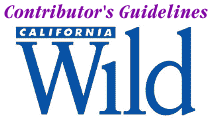

CALIFORNIA WILD: Natural Sciences for Thinking Animals (formerly Pacific Discovery) is a quarterly magazine published by the California Academy of Sciences, the research facility, natural history museum, and aquarium in San Francisco's Golden Gate Park. Circulation is approximately 30,000.
California Wild's readers are well-educated, and most are residents of California. They are concerned about environmental issues and are committed to informing themselves and others about the natural world. Our readers' interests range widely, from ecology to geology, from endangered species to anthropology, from field identification of plants and birds to an armchair understanding of complex scientific issues.
Articles should avoid a textbook style. Though topics should be interesting scientifically, articles must also tell a story and illuminate the greater significance and timeliness of a subject. New information, new theories, new research should be featured prominently. Where there is controversy it is fine to take a stance, but opposing arguments should be aired. We prefer to emphasize possible solutions to conservation and environmental issues, rather than list problems. We're primarily looking for stories within our geographic region, which includes California and adjacent seas and regions, but almost every issue contains something farther afield.
Departments: Skywatcher: An account of recent research in a field of astronomy: 2,000-3000 words. Wild Lives: A description of unusual behavior in a particular species or genus: 1,000 words plus excellent photos. Trail Less Traveled: A 1,000-word description of the fauna and flora seen along a little known, but not too strenuous, hike.
We purchase first North American serial rights and we also request electronic rights, as a version of California Wild is available through the Internet. Payment is 25 cents per word, two weeks prior to publication. Articles range in length from 1,000 to 3,000 words. Most authors are asked to submit on speculation.
Authors of articles typically are well-informed professional writers or authoritative scientists with experience writing for popular audiences. Authors should interview and quote specialists and other authorities. There can be a primary source but use more than one source. Some first-hand experience with the subject is also appreciated.
Query letters: A proposal should take the form of the proposed story's opening paragraphs, followed by a description or outline of the remaining text. Faxed queries are fine, but we don't encourage email queries.
Style of articles should be friendly, anecdotal, and thorough. We prefer to avoid technical language and to define specialized terms only when the words themselves and the concepts they embody are appropriate to the story. Regardless of the complexity of the subject matter, authors should try to write simply, using short sentences and paragraphs of not more than four or five sentences. Colloquial usages are fine as long as they're not carried to extremes. Stories should include fleshed out personalities, these may be scientists, environmentalists, or historical figures.
Manuscripts should be neat, typed double-spaced, with margins of not less than one and one-quarter inches all around. The author, abbreviated title, and page number should be typed in the upper right corner of every page. The first page must include the author's name, address, telephone number, Social Security number, and a close estimate of the number of words in the article. Once a manuscript is accepted, we will request a computer disk, if one is available. The story should be saved in MS-Word or text only.
Style Tips: Include scientific names in parentheses after common names of species. Spell out numbers from one to twelve and use numerals for measurements. Refer to The Chicago Manual of Style.
Source Documentation must be available for every manuscript. Authors should be prepared to provide a list including complete information about publications consulted and interviews conducted, including the name, title, address and telephone number of each source.
Photography
Photographs should be submitted in the form of original color transparencies or reproduction-quality dupes. Color slides must be mounted in flexible, page-size sleeves and must also be protected with individual slide protectors. Each transparency must be clearly marked on the cardboard mount itself with: the photographer's name and address, a sequencing number, and information describing the content of the photograph. Enclose a stamped, self-addressed envelope, return mailing instructions, and sufficient postage to cover safe return, including insurance if you wish. Our current photo needs are published in the Guilfoyle Report (Call (212) 929-0959 for information).
Most articles are illustrated. If an author has no direct access to photographs (the author's own or others), referrals to photographers with professional-quality material are appreciated. We rarely use photographs without an accompanying text. But the right photos might inspire us to find one. We also use photographs which 'tell a story' of a sequential event.
We purchase one-time publication rights to images. Payment ranges from $75 to $175 inside, and $200 for a cover. We may also use images, as part of pages in promotional material. In the unlikely event that an original transparency is lost or damaged, the Academy's liability is limited to fair market value, and we are not bound by any arbitrary valuations.
Captions, typed on separate pages, must be numbered to correlate with numbers on the photographs. Captions should be written as complete sentences, providing both primary and secondary information about the subject of the photograph. If the photographs include people, their names must be noted with correct spelling. Plants and animals should be carefully identified.
FOR A SAMPLE COPY, SEND A SELF-ADDRESSED, Stamped ENVELOPE WITH POSTAGE--$1.75. UNSOLICITED SUBMISSIONS OF ANY
KIND MUST BE ACCOMPANIED BY A SELF-ADDRESSED, STAMPED ENVELOPE LARGE ENOUGH, AND BEARING ENOUGH POSTAGE, TO ENSURE
SAFE RETURN.
![]()